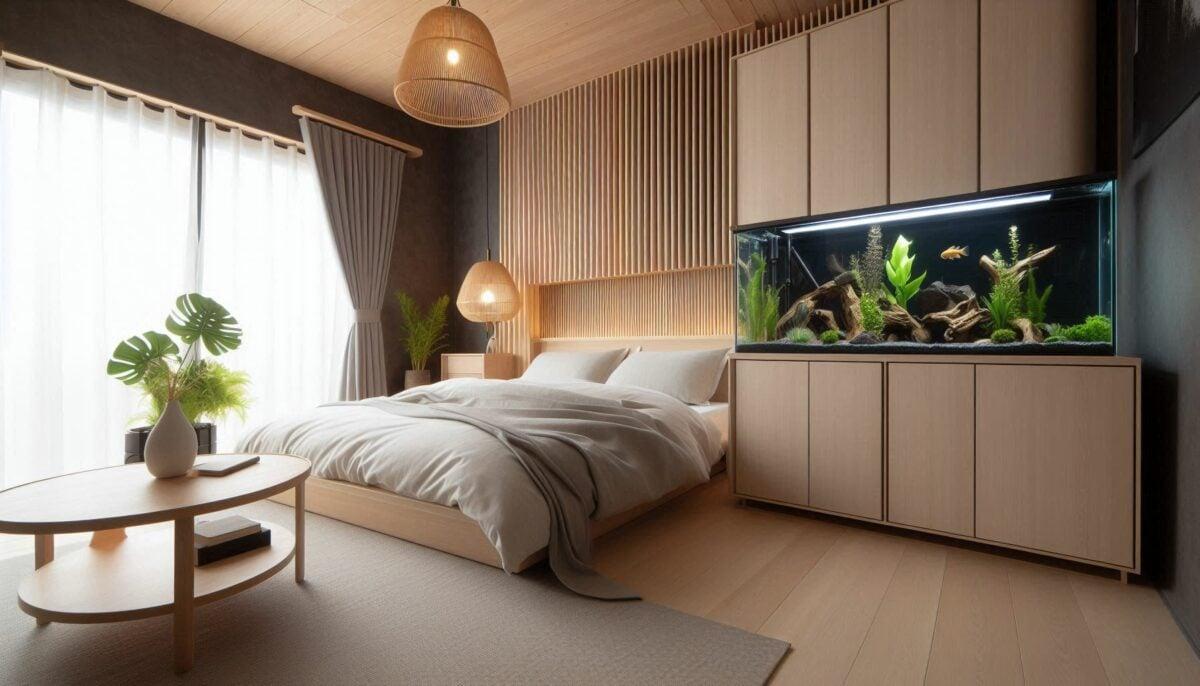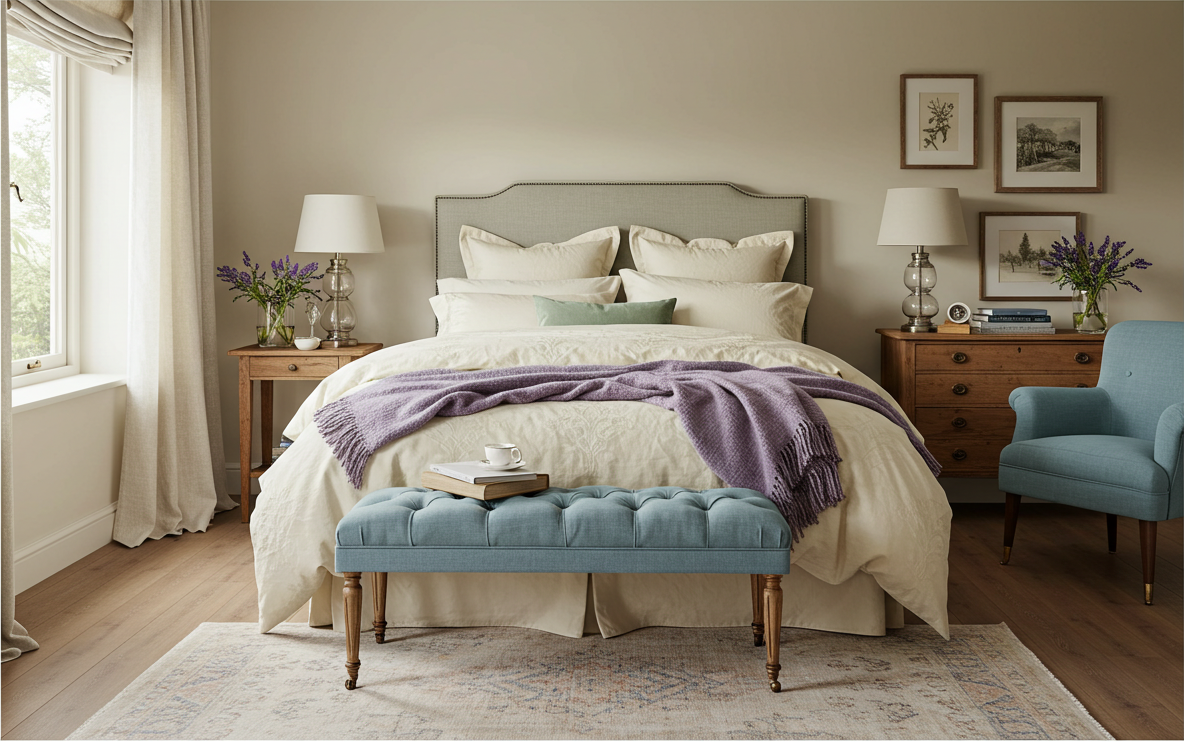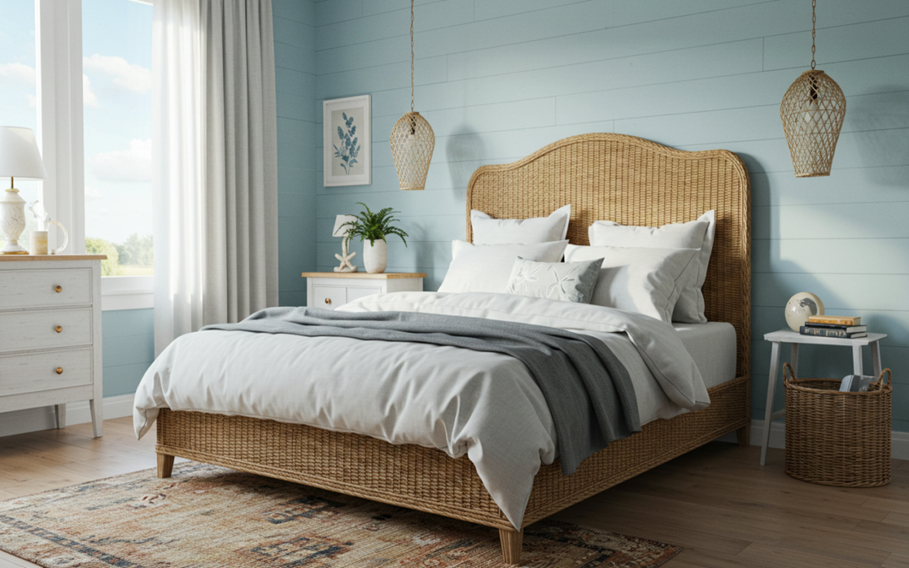Your bedroom should be your own personal sanctuary. A space where you can retreat from the outside world and truly be yourself. So why settle for ordinary when you can create something extraordinary?
Pinterest searches for ‘burgundy bedroom’ have soared by 70% in the last year, proving that 2025 is all about bold, personal expression in our most private spaces. The Panda London Sleep Report 2025 reveals something fascinating too – there’s a growing focus on creating calming environments that actually help you sleep better and wake up refreshed.
Whether you’re drawn to the clean lines of Scandinavian design, which continues to influence modern bedroom aesthetics, or you find yourself captivated by the peaceful simplicity of Japanese-inspired spaces, this year’s bedroom ideas have something special waiting for you.
Finding bedroom ideas that work in your space can feel challenging. But here’s the thing – with clever storage solutions and thoughtful design choices, you can turn any bedroom into a reflection of your personality. Built-in joinery can work wonders for storage if your space and budget allow, whilst the right bedding creates the perfect foundation for a beautiful, relaxing retreat.
Ready to discover some hidden gems? We’ll explore how different cultures approach bedroom design and show you exactly how to bring these stunning elements into your own space for 2025.
Scandinavian calm: simplicity and light
Scandinavian design has grown beyond those stark, cold spaces you might remember from the early 2000s. Today’s approach offers something much warmer and more inviting for 2025 bedroom ideas. This iconic style still champions simplicity, but now it balances serenity with genuine warmth—creating spaces that feel both airy and embracing.
Neutral tones and natural wood
Grey-beige continues to anchor Scandinavian bedrooms, offering both practicality and serenity in modern homes. But here’s what’s exciting for 2025—this timeless backdrop now welcomes richer companions like purple, brown, green, and gentle accents of lime green, lavender, and peach. What designers call “warm minimalism” has emerged—spaces that keep those clean lines whilst embracing comfort and emotional depth.
“Scandinavian-style interiors have a sense of balance and elegant simplicity that often features desaturated shades and off-whites,” explains colour expert Dominic Myland. “Muted colours and light-reflective tones bring a sense of space and calm to any room.”
The warming trend extends beautifully to materials too. Velvet has made a bold comeback, channeling that retro elegance of the 1960s, whilst natural woods like pine and burl add character and depth. Blonde wood remains a cornerstone of the Scandinavian palette, connecting your indoor space to the natural world. The result? What Fred Horlock, design director at Neptune, describes as “quiet confidence”—tranquil spaces that use natural textures and timeless materials.
Want authentic Scandinavian bedroom inspiration? Focus on these essentials:
- Light-coloured woods like oak, pine, ash and birch that bounce natural light around your room
- Earthy tones including clay, sand, olive green, and warm terracotta
- Natural textiles in neutral shades—linen and cotton work beautifully
- Minimal decoration where every piece has meaning and purpose
Functional furniture with soft edges
Something lovely has happened to Scandinavian furniture for 2025—it’s gone beautifully soft. Rounded edges on tables, armchairs, and sofas create a more inviting, tactile experience. This shift towards curved comfort gained momentum back in 2021 with the return of “crescent sofas”, reflecting our desire for spaces that feel nurturing after those challenging times.
“Introducing curves to a room softens its overall appearance, making it more inviting and creates fluidity within the space,” note design experts. Curved headboards work particularly well in bedrooms, establishing a tranquil tone whilst adding softness and elegance compared to sharp rectangular alternatives.
Multifunctionality remains central to Scandinavian thinking as our homes adapt to changing needs. Bedside tables with clever storage, daybeds that double as extra seating or guest accommodation—each piece earns its place by serving multiple purposes. The philosophy isn’t about having fewer things—it’s about having the right things.
Low-profile furniture with Japandi influences has become particularly popular in bedroom settings for 2025. These pieces create spaciousness whilst maintaining those clean Scandinavian lines. Brands like GUBI and ferm LIVING offer minimalist, low-profile options that bring elegance and relaxation to modern bedrooms.
Today’s Scandinavian bedroom furniture prioritises comfort alongside those beautiful clean aesthetics. The goal? Creating a space that feels carefully edited rather than empty—a decluttered, nurturing sanctuary that wraps you in understated style.
Japanese Zen: harmony through design
Japanese bedroom design offers something profound that goes beyond mere aesthetics. It’s about creating a space where your mind can truly rest, not just your body.
The philosophy is beautifully simple yet powerful – your physical environment directly impacts your mental wellbeing. This isn’t just about looking good; it’s about feeling genuinely peaceful when you step into your bedroom each evening.
Low beds and sliding partitions
The low-profile wooden bed frame sits at the heart of authentic Japanese design. These minimalist structures create the illusion of a floating bed—perfect for smaller spaces and minimalist living. The clever positioning of legs lifts your mattress just enough for proper air circulation whilst keeping that signature grounded feel.
“The minimalist frame creates the illusion of a floating bed – perfect for small, minimalist living,” explains one Japanese furniture specialist.
Traditional Japanese beds evolved from the simple futon—a thin, foldable mattress placed directly on the floor. Today’s versions honour this heritage but add thoughtful modern touches:
- Solid wood construction (typically oak or Scandinavian pine)
- Clean geometric lines with minimal ornamentation
- Recessed leg designs for that floating appearance
- Optional low headboards for gentle comfort
Image credit Bedstar: Japandi bedroom interior design.

Sliding partitions deserve special attention too. Unlike rigid doors that permanently divide rooms, these brilliant space-management solutions create flexibility. Shoji sliding doors, with their wooden lattice frames and translucent panels, diffuse light beautifully throughout your space, creating the softest, most tranquil illumination.
Tatami mats and bamboo accents
Tatami mats remain essential in authentic Japanese bedrooms. Traditionally crafted with rice straw cores (though modern versions often use synthetic materials), these distinctive floor coverings provide a springy yet firm texture that’s ideal for both sitting and sleeping.
But tatami mats offer much more than visual appeal. Their natural breathability allows air circulation beneath futons and mattresses, preventing moisture buildup—crucial for proper sleep hygiene. The tactile experience connects you directly to natural materials, making your bedroom feel more grounded and peaceful.
Bamboo accents strengthen this connection to nature even further. As a rapidly renewable resource, bamboo brings sustainability alongside distinctive visual appeal.
“Bamboo is excellent for zen-inspired bedrooms due to its natural origins, softness, and sustainability,” note interior design experts.
Wood appears throughout Japanese design—in window frames, internal partitions, and furniture elements. This prevalence of natural materials creates warmth that contrasts beautifully with clean lines and minimal decoration.
Decluttering for mental clarity
Here’s where Japanese design gets really interesting. The emphasis on decluttering isn’t just about tidiness—it’s about mental health.
“A cluttered home is often a reflection of a cluttered mind and can lead to feelings of overwhelm and stress,” explain decluttering specialists. Remove unnecessary items from your bedroom, and you create genuine space for tranquility and reflection.
Japanese design tackles this through intentional storage solutions and a disciplined approach to possessions. Traditional Japanese homes feature minimal, multipurpose furniture, with items stored away when not in use. This principle works beautifully in contemporary bedrooms.
“Order is at the heart of Japanese design, furniture elements are few and generally simple and the provision of storage is critical,” emphasise design experts.
Each item must earn its place through function or meaning. Decorative elements are chosen thoughtfully rather than accumulated randomly. The result? A space that feels both purposeful and peaceful—a true retreat from daily chaos.
Japanese Zen design offers a profound approach to bedroom inspiration for 2025 that goes beyond surface aesthetics, inviting you to create spaces that nurture both physical comfort and mental serenity.
British eclecticism: comfort with character
British bedroom style has character in spades. Where minimalist styles strip things back, British eclecticism celebrates the joy of collecting – creating spaces that feel lived-in, loved, and utterly personal.
Layered textiles and vintage finds
Here’s where British bedrooms truly shine – the art of layering. “Warmth, privacy, and a touch of luxury all collide when you layer your bedroom curtains,” suggests textile experts. This layering philosophy doesn’t stop at windows though. Every surface becomes an opportunity to add texture and personality.
Your bed deserves the full treatment. Start with quality linens, then have some fun:
- Add a matelassé coverlet in contrasting fabric for that coveted “quilted look that turns a bed into a marshmallow retreat”
- Let throws drape “romantically over the end of the bed and onto the floor”
- Mix cushions in different patterns that complement rather than match perfectly
Don’t worry about everything looking pristine. “While everything will no doubt have a carefully chosen ‘place’ in the bedroom, it doesn’t have to be pressed into a perfect square or roll in order to look as though it belongs,” note design specialists. This deliberate imperfection is what makes British style so appealing.

Image credit Bedstar: British style bedroom set, double divan bed.
The magic happens when you embrace textural variety. “Successfully styling your bed is all about having a range of textures that contrast with one another. Think crisp Egyptian bed linen topped with a chunky wool blanket, or a matte velvet headboard styled with shiny silk cushions,” advise British textile experts.
Mixing old and new with intention
British eclecticism excels at bringing together different eras and styles. “The mix of styles and periods, of old and new, high and low, of bespoke and off the shelf” creates what designer Duncan Campbell describes as “a perfect dinner party” of elements.
Want to master this look? Remember that “objects in a room talk to each other”. Start with neutral backdrops for walls and floors, then let your personality pieces take centre stage without overwhelming the space.
Hunt for vintage treasures – antique beds, painted furniture, or flea market finds – and pair them with contemporary pieces. Charlotte Moss captures this beautifully: “one of the greatest things that can happen to you in decorating is the spontaneous, serendipitous moment when you stumble onto something”.
Colour coordination matters too. British eclectic bedrooms often feature “moody paint shades in ultra-matte finishes” that “accentuate textures in fabrics and make bold colours pop”. The style has evolved beyond traditional palettes to include unexpected hues that still maintain the room’s distinctive character.
If you’re seeking authentic British character in your bedroom, hold onto this truth: “surrounding yourself with the things you love is good for the soul”. That philosophy perfectly captures what British eclecticism is all about.
Australian coastal style: nature indoors
Australian coastal style brings the outdoors straight into your bedroom. This approach blends beachside elements with relaxed living, creating spaces that feel both refreshing and grounded – perfect for unwinding after those long days.
Breezy fabrics and ocean tones
The magic of Australian coastal bedrooms starts with a light, airy colour palette inspired by the sea and sky. Soft whites, seafoam greens, and sandy neutrals dominate walls and soft furnishings, creating that serene backdrop you’ve been dreaming of. These colours work brilliantly to reflect natural light, making your space feel more expansive.
Layering textures is where this style really comes alive. Light, breathable fabrics like linen and cotton form the heart of your bedding. The slightly crumpled look of linen sheets actually adds to the relaxed vibe – it’s less about perfection and more about pure comfort. Consider adding these coastal elements:
- Woven rugs that echo sandy beaches
- Timber furniture in light, natural finishes
- Rattan or cane pieces for texture and warmth
Indoor-outdoor flow in bedroom design
What sets Australian coastal design apart? Those spacious living areas that flow seamlessly onto outdoor zones. Large sliding or bi-fold glass doors blur the boundaries between inside and out, inviting those beautiful sea breezes throughout your space.
For your bedroom ideas in 2025, clerestory windows or skylights can enhance this natural connection. Consistent flooring materials that extend from your bedroom to balcony or deck create visual continuity. Sheer curtains that move gently with the breeze allow privacy whilst maintaining that essential link to nature.
Using plants to soften the space
Plants breathe life into Australian coastal bedrooms, adding fresh colour and texture that complements soft neutrals perfectly. Mix different leaf shapes and sizes for coastal bedroom ideas – perhaps a large statement plant like a fiddle leaf fig alongside smaller succulents.
These living elements don’t just look beautiful; they improve air quality and boost your mood too. Try trailing vines on shelves or potted palms near windows to bring instant freshness into your room. For that authentic Australian feel, select plants that echo the coastal environment – native grasses or even herbs like rosemary that subtly remind you of salty air.
Image credit Bedstar: Coastal bedroom interior decor.

French and Moroccan fusion: elegance meets vibrancy
The marriage of French and Moroccan design creates bedrooms that absolutely captivate with their perfect balance of sophistication and warmth. This fusion style has become increasingly popular among designers who want to blend European elegance with North African soul.
Chic minimalism with ornate details
French minimalism gives you the ideal backdrop for those gorgeous Moroccan flourishes. Picture sleek, uncluttered spaces punctuated by carefully chosen ornate elements – think intricate mosaic tilework and elaborate metalwork that add visual drama without overwhelming your space.
Tadelakt plaster finishes are a hallmark of authentic Moroccan interiors, creating those lustrous, tactile surfaces that feel amazing to touch whilst complementing clean French lines beautifully. Architectural vaults and archways with delicate detailing bring Islamic influences into your bedroom while maintaining those sophisticated proportions that make French design so timeless.
Using colour and pattern with restraint
Here’s where this fusion style gets really interesting. Whilst Moroccan design is traditionally known for vibrant colours, contemporary French-Moroccan bedrooms use colour strategically rather than boldly. Neutral schemes get punctuated by jewel tones, creating sophisticated spaces where pattern becomes the star.
Consider these colour combinations for your bedroom:
- Deep blues, reds and terracotta for instant warmth
- Pink and blue pairings for vibrancy that still feels controlled
- Neutral backgrounds that let your ornate details really shine
Bamboo and antique blends
Bamboo furniture adds wonderful texture and visual interest to this fusion approach. Faux bamboo pieces – often crafted from pine, oak or maple but carved to look like bamboo – give you that distinctive aesthetic with better durability than the real thing.
These elements pair beautifully with French antiques, creating an eclectic mix that feels collected over time rather than bought all at once. The blending of Moroccan octagonal tables with bamboo lamp tables creates a sophisticated, worldly atmosphere that tells your story through carefully curated pieces.
Your dream bedroom awaits
Bedroom design goes far beyond choosing pretty colours – it’s about creating a space that truly reflects who you are. After exploring these incredible global inspirations, one thing becomes crystal clear: the most stunning bedrooms don’t follow rules, they blend ideas that speak to you.
Think about what draws you in. Maybe it’s the warm minimalism of Scandinavian design with those gorgeous neutral tones and natural woods. Perhaps Japanese Zen calls to you with its low beds and peaceful decluttering approach. British eclecticism might be your style – all those layered textiles and vintage treasures mixed with modern pieces. Australian coastal vibes could be perfect for you, bringing nature indoors with breezy fabrics and ocean-inspired colours. Or maybe French and Moroccan fusion captures your heart, balancing elegant simplicity with vibrant, ornate details.
Here’s what’s exciting – your ideal bedroom doesn’t need to stick to just one style. You might love the mental clarity that comes with Japanese design but crave the cosy textures of British eclecticism. Why not combine Australian coastal freshness with the soft curves of Scandinavian furniture?
Quality sleep needs both physical comfort and emotional connection. Your bedroom should feel like coming home to yourself every single day.
The beauty of these global inspirations lies in how adaptable they are. Whether you’re working with a tiny city apartment or a spacious suburban bedroom, these design principles can work for your space and budget.
Ready to get started?
Take a moment to consider which elements really speak to you before making any big changes. Sometimes the smallest adjustments can make the biggest difference – introducing natural materials, switching up your colour palette, or simply decluttering unnecessary items can completely change how your space feels.
Remember, your bedroom should tell your story. The most beautiful bedrooms around the world have one thing in common – they feel authentic, not staged. So as you bring these global influences into your own space, make sure they serve your comfort and reflect what makes a bedroom truly beautiful to you.
Your personal sanctuary is waiting. Which inspiration will you start with?
Lynn Martelli is an editor at Readability. She received her MFA in Creative Writing from Antioch University and has worked as an editor for over 10 years. Lynn has edited a wide variety of books, including fiction, non-fiction, memoirs, and more. In her free time, Lynn enjoys reading, writing, and spending time with her family and friends.















